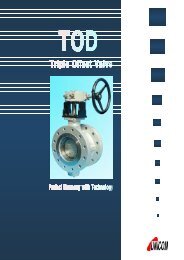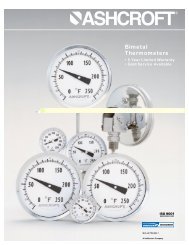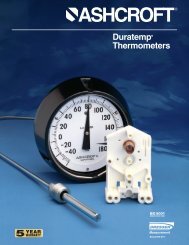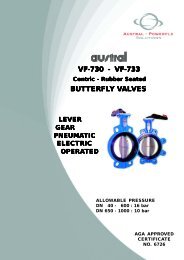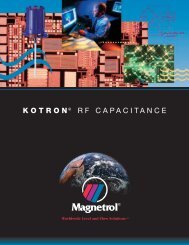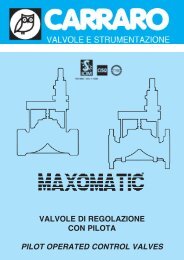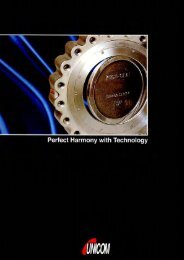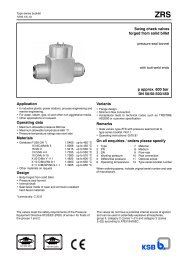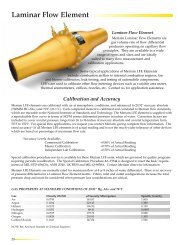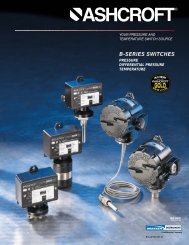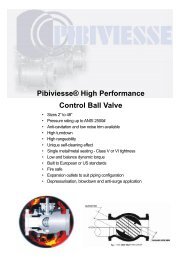B-SERIES SWITCHES
B-SERIES SWITCHES
B-SERIES SWITCHES
Create successful ePaper yourself
Turn your PDF publications into a flip-book with our unique Google optimized e-Paper software.
PRODUCT SELECTION INFORMATION<br />
(single pole-double throw), or 2 (SPDT).<br />
Refer to catalog pages for switch element<br />
choices. Select a switch element with electrical<br />
rating that exceeds the electrical rating of<br />
the device being controlled by the switch.<br />
For better reliability and safety, optional<br />
Hermetically Sealed switching elements<br />
may be specified.<br />
ADDITIONAL SWITCH TERMINOLOGY<br />
Accuracy – (see repeatability) Accuracy normally<br />
refers to conformity of an indicated<br />
value to an accepted standard value. There is<br />
no indication in switch products; thus,<br />
instead, the term repeatability is used as the<br />
key performance measure.<br />
Automatic Reset Switch – Switch which<br />
returns to normal state when actuating variable<br />
(pressure or temperature) is reduced.<br />
Adjustable or Operating Range – That part<br />
of the nominal range over which the switch<br />
setpoint may be adjusted. Normally about<br />
15% to 100% of the nominal range for pressure<br />
and differential pressure switches and<br />
the full span for temperature switches.<br />
Burst Pressure – The maximum pressure<br />
that may be applied to a pressure switch<br />
without causing leakage or rupture. This is<br />
normally at least 400% of nominal range for<br />
Ashcroft switches. Switches subjected to<br />
pressures above the nominal range can be<br />
permanently damaged.<br />
Deadband – The difference between the setpoint<br />
and the reset point, normally<br />
expressed in units of the actuating variable.<br />
Sometimes referred to as differential.<br />
Division 1 – A National Electrical Code Classification<br />
of hazardous locations. In Division<br />
1 locations, hazardous concentrations of<br />
flammable gases or vapors exist continuously,<br />
intermittently or periodically under normal<br />
conditions; frequently because of repair or<br />
maintenance operation/leakage or due to<br />
breakdown or faulty operation of equipment<br />
or processes which might also cause simultaneous<br />
failure of electrical equipment.<br />
Explosion-proof NEMA 7/9 enclosures are<br />
required in Division 1 locations.<br />
Division 2 – A National Electrical Code Classification<br />
of Hazardous locations. In Division<br />
2 hazardous locations, flammable or volatile<br />
liquid or flammable gases are handled,<br />
processed or used, but will normally be confined<br />
within closed containers or closed systems<br />
from which they can escape only in<br />
case of accidental rupture or breakdown or<br />
in case of abnormal operation of equipment.<br />
Either Nema 7/9 explosion-proof enclosures<br />
or any enclosure with hermetically sealed<br />
switch contacts may be used in Division 2<br />
locations.<br />
Explosion Proof – A term commonly used<br />
in industry referring to enclosures capable of<br />
withstanding an internal explosion of a specified<br />
gas without igniting surrounding gases.<br />
Strict installation practices in accordance<br />
with the national electrical code are also<br />
required for safety.<br />
Fixed Deadband – The difference between<br />
the setpoint and the reset point of a pressure<br />
or temperature switch. It further signifies<br />
that this deadband is a fixed function of the<br />
pressure switch and not adjustable.<br />
Hermetically Sealed Switch – A switch element<br />
whose contacts are completely sealed<br />
from the environment to provide additional<br />
safety and reliability. Contact arc cannot<br />
cause an explosion, and atmospheric corrosive<br />
elements cannot affect the contacts.<br />
Manual Reset Switch – Pressure or Temperature<br />
switch in which contacts remain<br />
actuated even after the actuating variable<br />
returns to normal. On Ashcroft manual reset<br />
switches, a button must be pushed to reset<br />
the contacts.<br />
National Electrical Manufacturers Association<br />
(NEMA) – This group has defined several<br />
categories of enclosures, usually referred<br />
to as “types.” Further, they designate certain<br />
features and capabilities each type must<br />
include. For example, among other features,<br />
a NEMA 4 enclosure must include a threaded<br />
conduit connector, external mounting provision<br />
and cover gaskets. When selecting a<br />
NEMA 4 enclosure from any manufacturer, a<br />
buyer is assured of receiving these features.<br />
NEMA 4 – Watertight and dusttight enclosures<br />
intended for use indoors or outdoors<br />
to protect the equipment against splashing,<br />
falling or hose-directed water, external condensation<br />
and water seepage. They are also<br />
sleet-resistant.<br />
NEMA 4X – Watertight, dusttight and corrosion-resistant<br />
enclosures with same qualifications<br />
as NEMA 4, but with added corrosion<br />
resistance.<br />
NEMA 7 – Enclosures for indoor Class I,<br />
Division 1 Hazardous locations with gas or<br />
vapor atmospheres.<br />
NEMA 9 – Enclosures for indoor Class II,<br />
Division 1 Hazardous locations with combustible<br />
dust atmospheres.<br />
Normal Switch Position – Contact position<br />
before actuating pressure (or variable) is<br />
applied. Normally closed contacts open<br />
when the switch is actuated. Normally open<br />
contacts close when the switch is actuated.<br />
Normally Closed – Refers to switch contacts<br />
that are closed in the normal switch state or<br />
position (unactuated). A pressure change<br />
opens the contacts.<br />
Normally Open Switch – Refers to the contacts<br />
that are open in the normal switch<br />
state or position (unactuated). A pressure<br />
change closes the contacts.<br />
Overpressure Rating(s) – A nonspecific<br />
term that could refer to either burst or proof<br />
pressure, or both.<br />
Proof Pressure – The maximum pressure<br />
which may be applied without causing damage.<br />
This is determined under strict laboratory<br />
conditions including controlled rate of<br />
change and temperature: This value is for<br />
reference only. Consult factory for applications<br />
where switch must operate at pressures<br />
above nominal range.<br />
Repeatability (Accuracy) – The closeness of<br />
agreement among a number of consecutive<br />
measurements of the output setpoint for the<br />
same value of the input under the same<br />
operating conditions, approaching from the<br />
same direction, for full-range traverses.<br />
Note: It is usually measured as nonrepeatability<br />
and expressed as repeatability in percent<br />
of span or nominal range. It does not<br />
include hysteresis or deadband.<br />
Reset Point – The reset point is the Pressure,<br />
Temperature or Differential Pressure<br />
Value where the electrical switch contacts<br />
will return to their original or normal position<br />
after the switch has activated.<br />
Setpoint – The setpoint is the Pressure,<br />
Temperature or Differential Pressure value at<br />
which the electrical circuit of a switch will<br />
change state or actuate. It should be specified<br />
either on increase or decrease of that<br />
variable. (See also reset point.)<br />
Single-Pole Double Throw (SPDT) Switching<br />
Element – A SPDT switching element<br />
has one normally open, one normally closed,<br />
and one common terminal. The switch can<br />
be wired with the circuit either normally<br />
open (N/O) or normally closed (N/C). SPDT<br />
is standard with most Ashcroft pressure and<br />
temperature switches.<br />
Snap Action – In switch terminology, snap<br />
action generally refers to the action of contacts<br />
in the switch element. These contacts<br />
open and close quickly and snap closed with<br />
sufficient pressure to firmly establish an<br />
electrical circuit. The term distinguishes<br />
products from mercury bottle types that<br />
were subject to vibration problems.<br />
Static Pressure – For differential pressure<br />
switches, static pressure refers to the lower<br />
of the two pressures applied to the actuator.<br />
11



